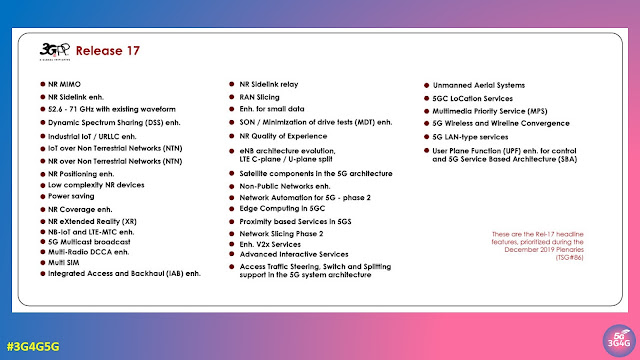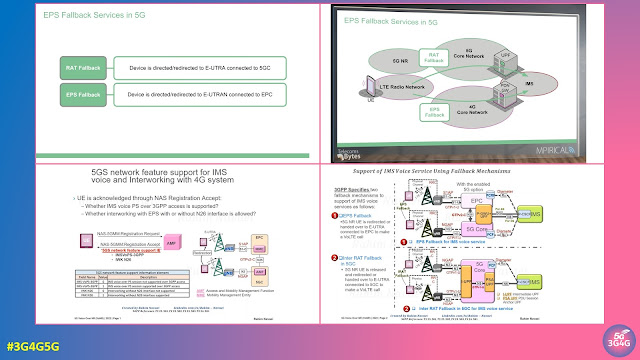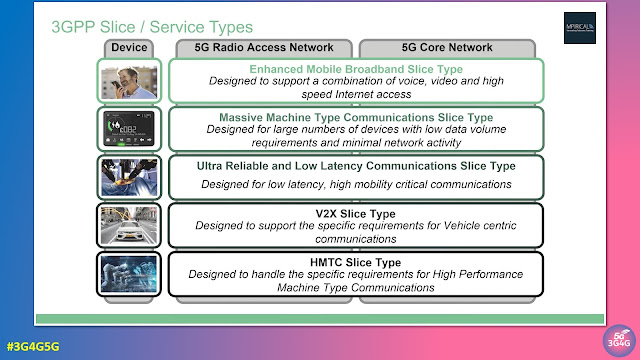An updated (looks final) version of 3GPP TR 21.917: Release 17 Description; Summary of Rel-17 Work Items was added to the archive earlier this month. It is a fantastic summary of all the Rel-17 features. Quoting the executive summary from the specs:
Release 17 is dedicated to consolidate and enhance the concepts and functionalities introduced in the previous Releases, while introducing a small number of brand new Features.
The improvements relate to all the key areas of the previous Releases: services to the industry (the "verticals"), including positioning, private network, etc.; improvements for several aspects of 5G supporting Internet of Things (IoT), both in the Core Network and in the Access Network, of proximity (direct) communications between mobiles, in particular in the context of autonomous driving (V2X), in several media aspects of the user plane related to the entertainment industry (codec, streaming, broadcasting) and also of the support of Mission Critical communications. Furthermore, a number of network functionalities have been improved, e.g. for slicing, traffic steering and Edge-computing.
The Radio interface and the Access Network have been significantly improved too (MIMO, Repeaters, 1024QAM modulation for downlink, etc.). While most of the improvements target 5G/NR radio access (or are access-agnostic), some improvements are dedicated to 4G/LTE access. Such improvements are clearly identified in the title and in the chapters where they appear.
Note: To avoid terminology such as "even further improvements of…", the successive enhancements are now referred to as "Phase n": "phase 2" refers to the first series of enhancements, "Phase 3" to the enhancements of the enhancements, etc. In this transition Release, the "Phase n" way of referring to successive enhancements has not always been used consistently nor enforced.
As for the new Features, the main new Feature of this Release is the support of satellite access, and a dedicated chapter covers this topic.
Note that the classifications, groupings and order of appearance of the Features in this document reflect a number of choices by the editor as there is no "3GPP endorsement" for classification/order. This Executive Summary has also been written by the editor and represents his view.
The following list is from the table of contents to provide you an idea and if it interests you, download the technical report here.
5.1.1 SA and CT aspects
5.1.2 RAN aspects
5.2 NB-IoT/eMTC support for Non-Terrestrial Networks
6.1 Introduction
6.2 Generic functionalities, to all verticals
6.2.1 Network and application enablement for verticals
6.2.1.1 Enhanced Service Enabler Architecture Layer for Verticals
6.2.1.2 Enhancements for Cyber-physical control Applications in Vertical domains (eCAV)
6.2.1.3 Enhancements of 3GPP Northbound Interfaces and APIs
6.2.2 Location and positioning
6.2.2.1 RAN aspects of NR positioning enhancements
6.2.2.2 Enhancement to the 5GC LoCation Services-Phase 2
6.2.3 Support of Non-Public and Private Networks
6.2.3.1 Enhanced support of Non-Public Networks
6.2.3.2 Enhancement of Private Network support for NG-RAN
6.3 Specific verticals support
6.3.1 Railways
6.3.1.1 Enhancements to Application Architecture for the Mobile Communication System for Railways Phase 2
6.3.1.2 Enhanced NR support for high speed train scenario (NR_HST)
6.3.1.2.1 NR_HST for FR1
6.3.1.2.2 NR_HST for FR2
6.3.1.3 NR Frequency bands for Railways
6.3.1.3.1 Introduction of 900MHz NR band for Europe for Rail Mobile Radio (RMR)
6.3.1.3.2 Introduction of 1900MHz NR TDD band for Europe for Rail Mobile Radio (RMR)
6.3.2 Mission Critical (MC) and priority service
6.3.2.1 Mission Critical Push-to-talk Phase 3
6.3.2.2 Mission Critical Data Phase 3
6.3.2.3 Mission Critical security Phase 2
6.3.2.4 Mission Critical Services over 5GS
6.3.2.5 Enhanced Mission Critical Communication Interworking with Land Mobile Radio Systems (CT aspects)
6.3.2.6 Mission Critical system migration and interconnection (CT aspects)
6.2.3.7 MC services support on IOPS mode of operation
6.3.2.8 MCPTT in Railways
6.3.2.9 Multimedia Priority Service (MPS) Phase 2
6.3.3 Drone/UAS/UAV/EAV
6.3.3.1 Introduction
6.3.3.2 General aspects
6.3.3.2.1 5G Enhancement for UAVs
6.3.3.2.2 Application layer support for UAS
6.3.3.3 Remote Identification of UAS
6.3.4 Media production, professional video and Multicast-Broadcast
6.3.4.1 Communication for Critical Medical Applications
6.3.4.2 Audio-Visual Service Production
6.3.4.3 Multicast-Broadcast Services (MBS)
6.3.4.3.1 Multicast-broadcast services in 5G
6.3.4.3.2 NR multicast and broadcast services
6.3.4.3.3 5G multicast and broadcast services
6.3.4.3.4 Security Aspects of Enhancements for 5G MBS
6.3.4.4 Study on Multicast Architecture Enhancements for 5G Media Streaming
6.3.4.5 5G Multicast-Broadcast User Service Architecture and related 5GMS Extensions
6.3.4.6 Other media and broadcast aspects
6.4 Other "verticals" aspects
7.1 NR small data transmissions in INACTIVE state
7.2 Additional enhancements for NB-IoT and LTE-MTC
7.3 Enhanced Industrial IoT and URLLC support for NR
7.4 Support of Enhanced Industrial IoT (IIoT)
7.5 Support of reduced capability NR devices
7.6 IoT and 5G access via Satellite/Non-Terrestrial (NTN) link
7.7 Charging enhancement for URLLC and CIoT
7.8 Messaging in 5G
8.1 Enhanced Relays for Energy eFficiency and Extensive Coverage
8.2 Proximity-based Services in 5GS
8.3 Sidelink/Device-to-Device (D2D)
8.3.1 NR Sidelink enhancement
8.3.2 NR Sidelink Relay
8.4 Vehicle-to-Everything (V2X)
8.4.1 Support of advanced V2X services - Phase 2
8.4.2 Enhanced application layer support for V2X services
9.1 Edge computing
9.1.1 Enhancement of support for Edge Computing in 5G Core network
9.1.2 Enabling Edge Applications
9.1.3 Edge Computing Management
9.2 Slicing
9.2.1 Network Slicing Phase 2 (CN and AN aspects)
9.2.2 Network Slice charging based on 5G Data Connectivity
9.3 Access Traffic Steering, Switch and Splitting support in the 5G system architecture; Phase 2
9.4 Self-Organizing (SON)/Autonomous Network
9.4.1 Enhancement of data collection for SON/MDT in NR and EN-DC
9.4.2 Autonomous network levels
9.4.3 Enhancements of Self-Organizing Networks (SON)
9.5 Minimization of service Interruption
9.6 Policy and Charging Control enhancement
9.7 Multi-(U)SIM
9.7.1 Support for Multi-USIM Devices (System and CN aspects)
9.7.2 Support for Multi-SIM Devices for LTE/NR
10 Energy efficiency, power saving
10.1 UE power saving enhancements for NR
10.2 Enhancements on EE for 5G networks
10.3 Other energy efficiency aspects
11 New Radio (NR) physical layer enhancements
11.1 Further enhancements on MIMO for NR
11.2 MIMO Over-the-Air requirements for NR UEs
11.3 Enhancements to Integrated Access and Backhaul for NR
11.4 NR coverage enhancements
11.5 RF requirements for NR Repeaters
11.6 Introduction of DL 1024QAM for NR FR1
11.7 NR Carrier Aggregation
11.7.1 NR intra band Carrier Aggregation
11.7.2 NR inter band Carrier Aggregation
11.8 NR Dynamic Spectrum Sharing
11.9 Increasing UE power high limit for CA and DC
11.10 RF requirements enhancement for NR FR1
11.11 RF requirements further enhancements for NR FR2
11.12 NR measurement gap enhancements
11.13 UE RF requirements for Transparent Tx Diversity for NR
11.14 NR RRM further enhancement
11.15 Further enhancement on NR demodulation performance
11.16 Bandwidth combination set 4 (BCS4) for NR
11.17 Other NR related activities
11.18 NR new/modified bands
11.18.1 Introduction of 6GHz NR licensed bands
11.18.2 Extending current NR operation to 71 GHz
11.18.3 Other NR new/modified bands
12. New Radio (NR) enhancements other than layer 1
12.1 NR Uplink Data Compression (UDC)
12.2 NR QoE management and optimizations for diverse services
13 NR and LTE enhancements
13.1 NR and LTE layer 1 enhancements
13.1.1 High-power UE operation for fixed-wireless/vehicle-mounted use cases in LTE bands and NR bands
13.1.2 UE TRP and TRS requirements and test methodologies for FR1 (NR SA and EN-DC)
13.1.3 Other Dual Connectivity and Multi-RAT enhancements
13.2 NR and LTE enhancements other than layer 1
13.2.1 Enhanced eNB(s) architecture evolution for E-UTRAN and NG-RAN
13.2.2 Further Multi-RAT Dual-Connectivity enhancements
13.2.3 Further Multi-RAT Dual-Connectivity enhancements
14 LTE-only enhancements
14.1 LTE inter-band Carrier Aggregation
14.2 LTE new/modified bands
14.2.1 New bands and bandwidth allocation for 5G terrestrial broadcast - part 1
14.3 Other LTE bands-related aspects
15 User plane improvements
15.1 Immersive Teleconferencing and Telepresence for Remote Terminals
15.2 8K Television over 5G
15.3 5G Video Codec Characteristics
15.4 Handsets Featuring Non-Traditional Earpieces
15.5 Extension for headset interface tests of UE
15.6 Media Streaming AF Event Exposure
15.7 Restoration of PDN Connections in PGW-C/SMF Set
15.8 Other media and user plane aspects
16 Standalone Security aspects
16.1 Introduction
16.2 Authentication and key management for applications based on 3GPP credential in 5G (AKMA)
16.3 AKMA TLS protocol profiles
16.4 User Plane Integrity Protection for LTE
16.5 Non-Seamless WLAN offload authentication in 5GS
16.6 Generic Bootstrapping Architecture (GBA) into 5GC
16.7 Security Assurance Specification for 5G
16.8 Adapting BEST for use in 5G networks
16.9 Other security aspects
17 Signalling optimisations
17.1 Enhancement for the 5G Control Plane Steering of Roaming for UE in Connected mode
17.2 Same PCF selection for AMF and SMF
17.3 Enhancement of Inter-PLMN Roaming
17.4 Enhancement on the GTP-U entity restart
17.5 Packet Flow Description management enhancement
17.6 PAP/CHAP protocols usage in 5GS
17.7 Start of Pause of Charging via User Plane
17.8 Enhancement of Handover Optimization
17.9 Restoration of Profiles related to UDR
17.10 IP address pool information from UDM
17.11 Dynamic management of group-based event monitoring
17.12 Dynamically Changing AM Policies in the 5GC
17.13 Other aspects
18.1 Introduction
18.2 Enhanced Closed loop SLS Assurance
18.3 Enhancement of QoE Measurement Collection
18.4 Plug and connect support for management of Network Functions
18.5 Management of MDT enhancement in 5G
18.6 Management Aspects of 5G Network Sharing
18.7 Discovery of management services in 5G
18.8 Management of the enhanced tenant concept
18.9 Intent driven management service for mobile network
18.10 Improved support for NSA in the service-based management architecture
18.11 Additional Network Resource Model features
18.12 Charging for Local breakout roaming of data connectivity
18.13 File Management
18.14 Management data collection control and discovery
18.15 Other charging and management aspects
If you find them useful then please get the latest document from here.
Related Posts:
- The 3G4G Blog: 3GPP Release 16 Description and Summary of Work Items
- The 3G4G Blog: 3GPP Release-17 5G NR Reaches Completion
- The 3G4G Blog: ATIS Webinar on '5G Standards Development Update in 3GPP Release 17 and 18'
- The 3G4G Blog: 3GPP Release-18 Work Moves Into Focus as Release-17 Reaches Maturity
- The 3G4G Blog: Disaster Roaming in 3GPP Release-17
- The 3G4G Blog: DCCA Features and Enhancements in 5G New Radio
- The 3G4G Blog: AI/ML Enhancements in 5G-Advanced for Intelligent Network Automation
- The 3G4G Blog: 3GPP 5G Non Terrestrial Networks (NTN) Standardization Update
- The 3G4G Blog: Will Wi-Fi Help 3GPP Bring Reliable Connectivity Indoors?
- The 3G4G Blog: 3GPP Presentations from CEATEC Japan 2021
- The 3G4G Blog: Future Railway Mobile Communication System (FRMCS)
- The 3G4G Blog: Introduction to 5G Reduced Capability (RedCap) Devices

















